5G technology is one of the most rapidly adopted 5th-generation technologies worldwide after the vast success of 4G.
In this article, we are going to discuss consumer-centric 5G pros and cons that will help you make an informed decision about 5G.
What is 5G?
5G is the Fifth Generation technology that mainly focuses on providing higher internet speed to make life easier in many aspects.
The government can benefit from it by simplifying governance; students can benefit from it by having access to advanced lessons, lectures, and materials online; and the general public can benefit from it by having easy access to the internet wherever they are.
The Advantages of 5G Technology
5G technology promises to revolutionize various industries and improve day-to-day life for consumers. There are several advantages of 5G technology described below:
Fast Internet Speeds
As compared to 4G it has lightning-fast data rates. Up to 20Gbps (gigabits per second) data rate with average download speeds has been recorded at 186.3 Mbps in the U.S. While South Korea leads globally to achieve average speeds of 432 Mbps.
Downloading movies in seconds, high-quality video calls and audio are as seamless as ever, and streaming of high-quality content in the era of Netflix is uninterrupted, possible to provide uniform and consistent connectivity.
Virtually Zero Latency
With zero latency there will be less lag time between sending a request and receiving a response from a device on the network.
Because interactions between devices are seamless many operations are more effective and safe overall. Lower the latency and higher the download and upload speeds.
Very High Capacity
Another advantage of 5G Technology is that it can handle a huge amount of devices simultaneously, which can be most useful in highly populated areas where many people are using their phones and connected devices at the same time without much effect on the speeds.
Massive IOT Integration

Through the capacity to scale down in data rates, power, and mobility, 5G is intended to seamlessly connect a huge number of embedded sensors in practically anything, offering incredibly lean and affordable connection options. Smart cities are beginning to emerge.
Innovation and Economic Growth
With its fast speeds and zero latency, 5G can enable advancement in the field of virtual reality, augmented reality, self-driven vehicles, and Robotics The introduction of 5G networks may also lead to the creation of new jobs and economic expansion.
Professionals with the necessary skills will be required to develop, build, and manage these networks as more sectors adopt 5G technology.
5G Benefits for the Common People
- People can now control their personal computers with their smartphones.
- It is easier to multitask and handle multiple devices at the same time, like knowing the location and checking the weather service while talking on the phone.
- Online education, like distance learning, has become flexible. Students can now attend classes from anywhere in the world.
- Healthcare will become more accessible and affordable; doctors can treat patients located in remote areas.
- Any natural hazard, including earthquakes and tsunamis, may be identified earlier.
- Governmental organizations can make healthy use of 5G technology for monitoring and investigating in any part of the world.
- The lost person may be found using location services like Google Maps and the Global Positioning System (GPS).
The Disadvantages of 5G Technology
Although 5G technology has been explored and conceptualized to address all radio signal problems and challenges in the world of mobile phones, it has the following cons due to certain security concerns and a lack of technical improvement in the majority of geographic locations.
The following are the 5G drawbacks or 5G disadvantages:
Framework Requirements
Implementing 5G technology requires significant foundational progress. A large network of small cell pinnacles and transmitters that span both urban and rural areas is necessary to fully utilize the technology’s potential.
This foundation construction can be time-consuming, and expensive, and encounter opposition from neighboring networks because of concerns about how it will make them feel and potential health risks.

Limited Inclusion
Compared to 4G, 5G inclusion is still largely limited despite ongoing progress.
Some customers might not be able to take advantage of the benefits of 5G because of delays in achieving complete 5G availability in rural and remote areas.
This computerized division could make already existing gaps in access to innovation and data worse.
Signal Interference
The 5G technology’s greater recurrence groupings struggle with signal obstructing. Due to their relatively constrained frequency range, these signs are more susceptible to obstructions like buildings and trees.
As a result, the sign reach may be reduced, necessitating additional structure and careful planning for successful inclusion.
Device Compatibility
Consumers may need to upgrade their smartphones, and other devices in order to fully take use of 5G services because not all products are compatible with these networks.
Customers with incompatible devices may have trouble and additional expenditures as a result of the transition from 4G to 5G.
Safety Concerns
As 5G turns out to be more inescapable, the gamble of digital dangers and information breaks likewise increments.
The sheer volume of associated gadgets and the huge measures of information communicated make potential weaknesses that programmers can take advantage of.
It becomes basic to execute strong safety efforts to shield against potential digital assaults.
Impact on the Environment
Concerns regarding the 5G framework’s unavoidable impact arise from its widespread deployment.
E-waste and fossil fuel byproducts may increase as a result of the new innovation’s increased energy consumption and the production and disposal of electronic devices.
To minimize these ecological effects, policymakers and organizations need to concentrate on practicable practices.
5G Disadvantages for Common People
- 5G has been begun in a large portion of nations worldwide, so based on the user experience there, it is realized that the battery of these individuals’ smartphones depletes rapidly, so the telecommunications organizations are dealing with an answer in the future as new consumer bases are growing rapidly.
- Due to the high-speed internet service of 5G, smartphone data will get over quickly and carrier service may charge you more for data usage.
- The cellphone gets heated quickly if you are utilizing the 5G network on it. High-speed connectivity can cause the mobile device to become warm, exactly like whenever we are using wifi on the smartphone.
- Early adopters may experience lightning-fast connections, but as the number of 5G users grows, speeds might drop, similar to what we previously experienced with 4G.
- The most crucial fact for 5G consumers is that they must update devices that are compatible with 5G if they want to make use of all the benefits of 5G. Mobile users won’t be able to utilize 5G if their phones only have 4G.
FAQs
1. Is 5G Technology Safe for Human Health?
There is now no such evidence to support the claim that 5G innovation offers any health risks. Administrative entities have established certain welfare standards that telecom companies must follow when deploying 5G organizations.
2. Can I Use My Current Phone with 5G?
No, if you want the ability to use the network, you should get a new cell phone that supports 5G. Mobile devices powered by the Snapdragon 5G Portable Stages, for instance, are 5G-capable.
A few new mobile phones are already available that are designed to support 5G, and several transporters throughout the globe support the 5G remote organization. More mobile phones and transporter subscriptions will become available as the 5G deployment timeline moves further, as 5G innovation and 5G suitable devices become more commonplace.
3. Will 5G Replace Wi-Fi?
5G and Wi-Fi serve different purposes and coexist to provide seamless connectivity. While 5G is primarily designed for wide-area coverage, Wi-Fi excels in providing localized, high-speed connections in homes, offices, and public spaces. Both technologies complement each other, and it is unlikely that 5G will completely replace Wi-Fi.
4. How Will 5G Impact Business Operations?
5G technology can significantly impact business operations by enabling faster data transfer, improved communication, and enhanced IoT integration. This can lead to increased productivity, automation, and the development of innovative services and products. Industries like healthcare, manufacturing, logistics, and entertainment are poised to experience transformative changes.
5. What Is the Future of 5G Technology?
The future of 5G technology is promising, with ongoing advancements and continuous improvements in its infrastructure. As more devices become compatible with 5G networks, and coverage expands globally, we can expect a revolutionary shift in how we live, work, and interact with technology.
6. How Does 5G Contribute to Smart Cities?
5G technology plays a vital role in enabling the development of smart cities. Its high-speed, low-latency capabilities support various applications
